Re: Puer Tea: Ancient Caravans and Urban Chic
I watched the 4th video yesterday. So far it's the most interesting one for me (not that I didn't enjoy listening to that lady complain about everybody  )because it shows how tea changes hands. That buyer has to be one his toes. I wonder where the tea he turned down ended up.
)because it shows how tea changes hands. That buyer has to be one his toes. I wonder where the tea he turned down ended up.
Re: Puer Tea: Ancient Caravans and Urban Chic
this book is really a nice read 
as the author is research based and not into commercial ventures, its just so nice to read her writing, unlike the other tea talks nowadays that are just all tea propaganda
as the author is research based and not into commercial ventures, its just so nice to read her writing, unlike the other tea talks nowadays that are just all tea propaganda
Apr 24th, '14, 12:27
Posts: 702
Joined: Sep 4th, '10, 18:25
Scrolling: scrolling
Re: Puer Tea: Ancient Caravans and Urban Chic
The videos are really good, learned a lot! I should try and get the book...
Apr 24th, '14, 15:22
Posts: 1936
Joined: May 22nd, '06, 11:28
Location: Trapped inside a bamboo tong!
Contact:
hop_goblin
Re: Puer Tea: Ancient Caravans and Urban Chic
Saw all the videos. Does anyone know where I can buy some of Pu-Erh tea highlighted in the videos?
Re: Puer Tea: Ancient Caravans and Urban Chic
The book itself is excellent, and a very easy read. It does a particularly great job showing the different agendas and opinions surrounding pu'erh.
Re: Puer Tea: Ancient Caravans and Urban Chic
My copy of this book has not yet arrived. In the meantime I have been reading a different book from my order called The Story of Tea: A cultural History and Drinking Guide. It is a very informative book on the many facets of tea, worth reading.Puerlife wrote:I'm still waiting for my order to be shipped. There was only one copy left when I posted. Should've ordered, then postedNot a big deal, though.
Re: Puer Tea: Ancient Caravans and Urban Chic
what can be more enjoyable than a late night with a nice book, and some yiwu tea to go with it the stories from yiwu?
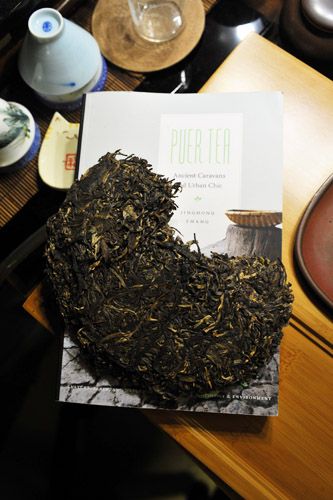
there are interesting excerpts from the book, i.e.
whilst producing fan for HK, the yunnanese continued to make mi for themselves. (mi = uncooked rice, fan = steamed cooked rice)
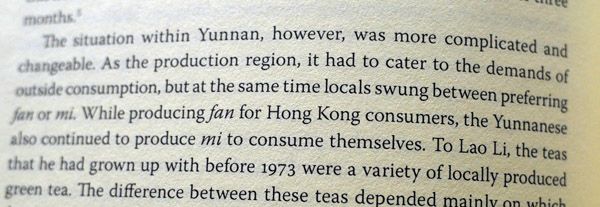
and essential point to divide oxidation and fermentation.
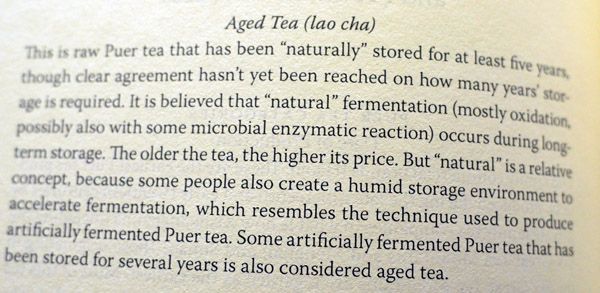
and what?!?! mr zheng of zheng si long tea company didnt touch that incredibly pricey red label tea?
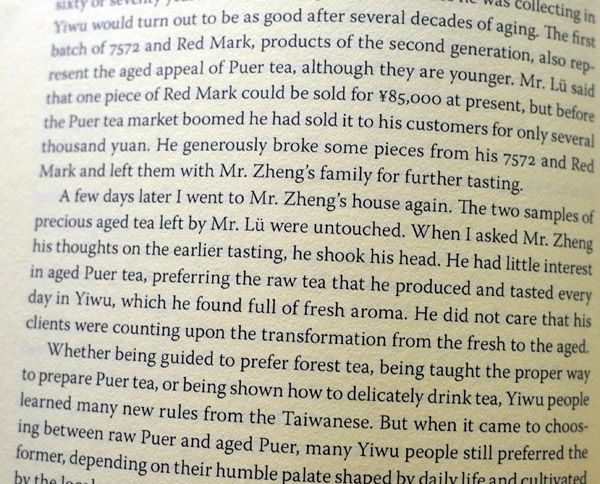
and essential differences in tea aromas. the typical HK style is pretty much the warehouse "qi" that influenced the tea apart from the weather
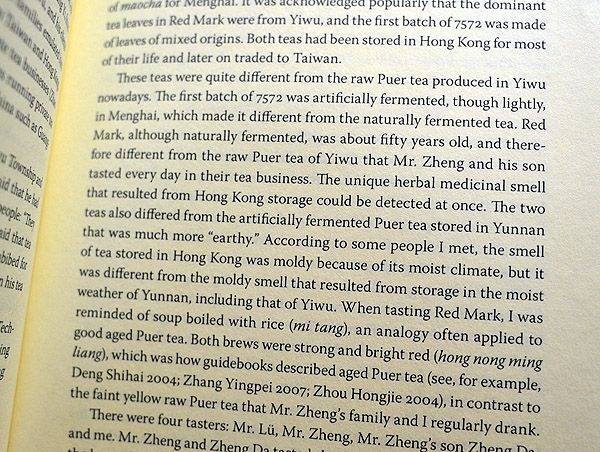
heh.. so much hatred for sealed storage, i was surprised that the author dared write about the sacrilegious matter.
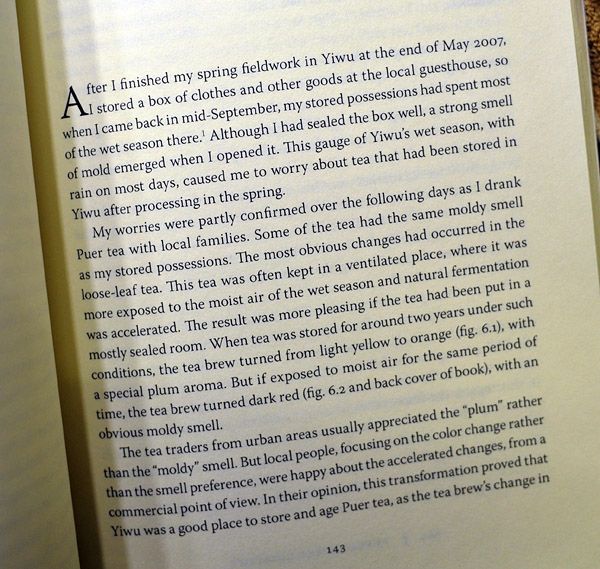
in summary
1) pu-erh is complicated business
2) the yunnanese had been drinking "sheng" pu-erh and that is their historical style
3) there's another school of thought, the HK style pu-erh
4) the taiwanese are damn good at stirfrying and trend setting
5) storage? hmm.... oh well..
6) contamination of forest tea with terrace materials
7) down to the source its sometimes faced with dishonesty from the harvesters
 yiwu tea, especially forest tea is not for everyone when they cannot tell the difference in the taste.
yiwu tea, especially forest tea is not for everyone when they cannot tell the difference in the taste.
9) lots of tea with no aroma. either land problem or overharvesting issues.
and many more! get a copy of the book now!!

there are interesting excerpts from the book, i.e.
whilst producing fan for HK, the yunnanese continued to make mi for themselves. (mi = uncooked rice, fan = steamed cooked rice)

and essential point to divide oxidation and fermentation.

and what?!?! mr zheng of zheng si long tea company didnt touch that incredibly pricey red label tea?

and essential differences in tea aromas. the typical HK style is pretty much the warehouse "qi" that influenced the tea apart from the weather

heh.. so much hatred for sealed storage, i was surprised that the author dared write about the sacrilegious matter.

in summary
1) pu-erh is complicated business
2) the yunnanese had been drinking "sheng" pu-erh and that is their historical style
3) there's another school of thought, the HK style pu-erh
4) the taiwanese are damn good at stirfrying and trend setting
5) storage? hmm.... oh well..
6) contamination of forest tea with terrace materials
7) down to the source its sometimes faced with dishonesty from the harvesters
9) lots of tea with no aroma. either land problem or overharvesting issues.
and many more! get a copy of the book now!!
Apr 30th, '14, 15:33
Posts: 445
Joined: Mar 25th, '13, 23:03
Location: Lexington Park, Maryland
Re: Puer Tea: Ancient Caravans and Urban Chic
Alright, I'm convinced. I will give it an order soon as I can.
M.
M.
Apr 30th, '14, 15:40
Posts: 1144
Joined: Jul 10th, '13, 01:38
Scrolling: scrolling
Location: Japan.
Re: Puer Tea: Ancient Caravans and Urban Chic
Seems interesting. I will order one copy!kyarazen wrote:
in summary
1) pu-erh is complicated business
2) the yunnanese had been drinking "sheng" pu-erh and that is their historical style
3) there's another school of thought, the HK style pu-erh
4) the taiwanese are damn good at stirfrying and trend setting
5) storage? hmm.... oh well..
6) contamination of forest tea with terrace materials
7) down to the source its sometimes faced with dishonesty from the harvesters
yiwu tea, especially forest tea is not for everyone when they cannot tell the difference in the taste.
9) lots of tea with no aroma. either land problem or overharvesting issues.
and many more! get a copy of the book now!!
Re: Puer Tea: Ancient Caravans and Urban Chic
That really does sound like a worthwhile book to read. I've been picking stuff together from random pdfs I find on the internet that mostly has to do with the history of the ancient trade.
I'm going to have to read the book, but pedantic me has the following comments:
1) yup
2) One should not underestimate the diversity with which Yunnanese drink and otherwise consume tea leaves. Nor underestimate the practicalities, like its use as medicine or ceremonies. "Sheng" is a little too big a blank, especially when shu was only systematized in the '70s, and only a distinct regional community ever really went for the funk.
3) Sorta, but that's almost like saying the Guangdong style of oolong.
4) They couldn't help but be trendsetting. China was frozen for decades, man. *Anyone* who really started things up as foreigners was going to be trendsetters, simply out of a renewed respect for quality.
5) perhaps
6-7-8) Not sure this is gone over in the book, but the profound trend since the last genuine hot spots came into trade, is the use of a single über-hot region to sell area-wide tea. This has resulted in most people with only the most tenuous grasp of the virtues of any specific sort of tea. This is driving a pretty big bifurcation of the market, between those that got the hookup, cash, and tasting experience, and the rest of the tea drinking society that has to go with "LBZ" or "GFZ" or "Bingdao". Ultimately, I think this will drive the next puerh crash, when people start caring about the actual qualities of a tea and there are no new suckers who want to brag about buying LBZ. And then reckon with how limited the good stuff is, compared to the demand.
9) There are some regions that produce virtuous tea with less aroma. The fixation on aroma character is characteristic of lower class northern Mainlanders and their familiarity with cheaper green tea. In general, as a practical matter, gushu tea will have less aroma than terraced tea. More durability and character, though. This fixation on aroma also drives poor manufacturing habits, particularly high temperature shaqing, or bake drying, because the resulting aroma can sell green tea'd cake for RMB 5k to people who think puerh should be like TGY.
Yeah, like that Zhensilong guy. I can only shake my head. If someone gave ME Red Mark, I'd be like that guy in the Bud Light commercials long ago, saying "I wuv you, man..." Zero class, zero clue. I know there's taste preferences and everything (and hey, maybe it's that he knows it's a poorly stored (or fake) Red Mark , and that's what the issue is). In any gold rush, there are always guys like that, who figure they can make a mint without understanding much of anything about what they are making (with the understanding that I've not read everything about Zheng). I used to like newborn tea fine, but at this point, I strongly prefer teas that are seven or more years old, dry or wet stored. And I think that will hold true for many people.
The liqueur color thing, I've always thought was kind of weird, because I don't attach it to anything I do care about. Would have to say that intense clear reds are very much appetizing, like what I get from my nice shu.
I have not had a tendency to like any one storage over any other. There isn't really a right way, except doing it the right way. I don't tend to like Banna storage because they don't tend to be stored all that well, regardless of moisture. I think that when people complain about Kunming storage, much of the problem is about poor technique rather than moisture, so to say.
I'm going to have to read the book, but pedantic me has the following comments:
1) yup
2) One should not underestimate the diversity with which Yunnanese drink and otherwise consume tea leaves. Nor underestimate the practicalities, like its use as medicine or ceremonies. "Sheng" is a little too big a blank, especially when shu was only systematized in the '70s, and only a distinct regional community ever really went for the funk.
3) Sorta, but that's almost like saying the Guangdong style of oolong.
4) They couldn't help but be trendsetting. China was frozen for decades, man. *Anyone* who really started things up as foreigners was going to be trendsetters, simply out of a renewed respect for quality.
5) perhaps
6-7-8) Not sure this is gone over in the book, but the profound trend since the last genuine hot spots came into trade, is the use of a single über-hot region to sell area-wide tea. This has resulted in most people with only the most tenuous grasp of the virtues of any specific sort of tea. This is driving a pretty big bifurcation of the market, between those that got the hookup, cash, and tasting experience, and the rest of the tea drinking society that has to go with "LBZ" or "GFZ" or "Bingdao". Ultimately, I think this will drive the next puerh crash, when people start caring about the actual qualities of a tea and there are no new suckers who want to brag about buying LBZ. And then reckon with how limited the good stuff is, compared to the demand.
9) There are some regions that produce virtuous tea with less aroma. The fixation on aroma character is characteristic of lower class northern Mainlanders and their familiarity with cheaper green tea. In general, as a practical matter, gushu tea will have less aroma than terraced tea. More durability and character, though. This fixation on aroma also drives poor manufacturing habits, particularly high temperature shaqing, or bake drying, because the resulting aroma can sell green tea'd cake for RMB 5k to people who think puerh should be like TGY.
Yeah, like that Zhensilong guy. I can only shake my head. If someone gave ME Red Mark, I'd be like that guy in the Bud Light commercials long ago, saying "I wuv you, man..." Zero class, zero clue. I know there's taste preferences and everything (and hey, maybe it's that he knows it's a poorly stored (or fake) Red Mark , and that's what the issue is). In any gold rush, there are always guys like that, who figure they can make a mint without understanding much of anything about what they are making (with the understanding that I've not read everything about Zheng). I used to like newborn tea fine, but at this point, I strongly prefer teas that are seven or more years old, dry or wet stored. And I think that will hold true for many people.
The liqueur color thing, I've always thought was kind of weird, because I don't attach it to anything I do care about. Would have to say that intense clear reds are very much appetizing, like what I get from my nice shu.
I have not had a tendency to like any one storage over any other. There isn't really a right way, except doing it the right way. I don't tend to like Banna storage because they don't tend to be stored all that well, regardless of moisture. I think that when people complain about Kunming storage, much of the problem is about poor technique rather than moisture, so to say.
Re: Puer Tea: Ancient Caravans and Urban Chic
based on the background of mr Lv, the redmark is quite definitely authentic. he led a group of venture capitalists and collectors, with collective funds to sweep and possibly monopolize all the stocks they could get their hands on in the early 90s, and he brought the cake to yiwu just in an attempt to let them know/understand the taste he is looking for.
he was also one of those whom had help pushed matters in Yiwu and for people to re-start tea harvesting and taking care of the bushes in the area
he was also one of those whom had help pushed matters in Yiwu and for people to re-start tea harvesting and taking care of the bushes in the area
Re: Puer Tea: Ancient Caravans and Urban Chic
Puerhlife and others, thank you for posting this!
The videos are great, they give a nice sense of how the farmers live and how puerh is made. I love that old farmer lady that complains all the time, she reminds me of my grandmother...
I've ordered the book, can't wait to get it...
The videos are great, they give a nice sense of how the farmers live and how puerh is made. I love that old farmer lady that complains all the time, she reminds me of my grandmother...
I've ordered the book, can't wait to get it...
Re: Puer Tea: Ancient Caravans and Urban Chic
Where are these videos people have posted about? What website?Puerlife wrote:I watched the 4th video yesterday. So far it's the most interesting one for me (not that I didn't enjoy listening to that lady complain about everybody)because it shows how tea changes hands. That buyer has to be one his toes. I wonder where the tea he turned down ended up.
May 3rd, '14, 00:19
Posts: 445
Joined: Mar 25th, '13, 23:03
Location: Lexington Park, Maryland